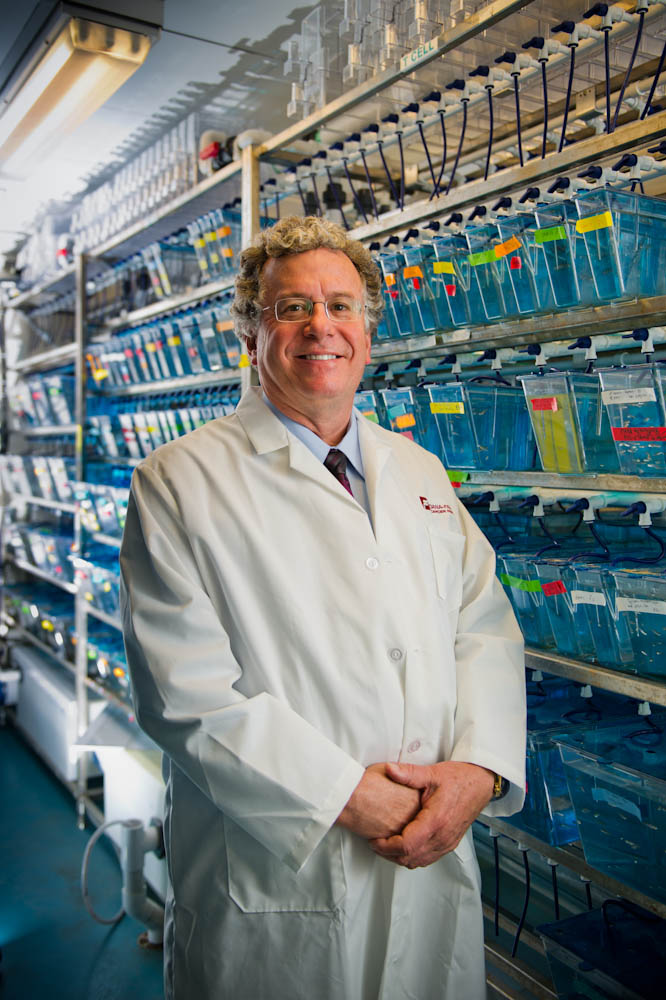By Tom Ulrich
One of the hot trends in drug discovery could be called drug re-discovery: finding new uses for drugs that have already received FDA approval for a different indication.
It’s an approach that allows researchers and clinicians to rapidly test potential treatments for rare or difficult-to-treat conditions. Because the drug’s safety profile is already known, much of the preclinical and early clinical work that goes into developing a drug can be bypassed.
It was this kind of strategy that Alejandro Gutierrez, MD, and A. Thomas Look, MD, of Dana-Farber/Boston Children’s Cancer and Blood Disorders Center, and Jon Aster, MD, PhD, of Dana-Farber Cancer Institute/Brigham and Women’s Cancer Center, had in mind when they started screening a library of nearly 5,000 FDA-approved compounds, off-patent drugs and natural products using a zebrafish model of T-cell acute lymphoblastic leukemia (T-ALL).
And with that strategy, they may have struck gold. Just not in the way they had expected.

When you mention ALL, what most people think of is B-cell ALL, the more common form of ALL and one that doctors can successfully cure in upwards of 90 or 95 percent of patients. T-ALL, however, is both more rare and more aggressive than its B-cell cousin. It’s also more deadly: Despite advances in medical treatments, it claims some 20 percent of children and more than 50 percent of adults diagnosed.
To improve those odds, Gutierrez, Look and Aster turned to zebrafish, a popular organism for cost-effective models for drug screening (and other research). Basically, you add the drug in question to their water and measure the effects.
“We wanted to see if there were drugs or known bioactive molecules that are active against T-ALL that hadn’t been tested yet,” says Look, a researcher with Dana-Farber/Boston Children’s and vice chair for research in Dana-Farber’s Department of Pediatric Oncology. “There may be drugs available for other indications that could be readily repurposed if we can show activity.”
Turning on, not off
As the team reported in the Journal of Clinical Investigation, one of the strongest “hits” in the screen was a drug called perphenazine. A member of a class of drugs called the phenothiazines, it’s a drug more widely known in psychiatry than oncology, because for 50 years, it’s been a mainstay treatment for patients with schizophrenia and other psychotic disorders.
Perphenazine works in the brain by blocking dopamine receptors. So why was it showing anti-cancer activity in the zebrafish model?

“We found that the mechanism by which perphenazine was killing cancer cells was independent of its antipsychotic activity,” says Gutierrez, who was a fellow in Look’s laboratory and who has recently established his own lab at Dana-Farber/Boston Children’s. “When we looked more closely, we found that the drug also activated a tumor-suppressing protein called PP2A.”
This is unusual. In general, anticancer drug research seeks to find proteins that are active only in cancer cells and develop ways to shut them off. But perphenazine was doing the opposite: In reactivating PP2A, the drug was reactivating a protein that the tumor cells had turned off, triggering the cells to die.
In other words, perphenazine was relieving the suppression on the suppressor, thereby forcing cancer cells in the model to die.
“We rarely find potential drug molecules that activate an enzyme,” Gutierrez explains. “But, here, perphenazine is restoring the activity of PP2A in the T-ALL cell.”
Perphenazine was relieving the suppression on the suppressor, thereby forcing cancer cells in the model to die.
The question now is whether it’s possible to develop drugs that have perphenazine’s anti-cancer activity but without its psychiatric effects, something the team and their colleagues are already evaluating.
“The challenge is to use medicinal chemistry to develop new PP2A activators similar to perphenazine and the other phenothiazines and to dial down dopamine interactions and accentuate those with PP2A,” says Look. He adds that PP2A activators wouldn’t necessarily work as magic bullets against T-ALL, but could help push teetering T-ALL cells over the edge.
“T-ALL patients are often on the borderline between a long remission and a cure,” he says. “If we can push the leukemia cells a little harder, we may get more patients who are actually cured. In this way, PP2A activators may, in combination with other drugs, make a real difference for patients.”
Added bonus
What if PP2A activation were good for more than just T-ALL? According to Gutierrez, the hints are there. “There’s epidemiologic data suggesting that patients taking these drugs for psychiatric reasons have lower rates of cancer in general,” he says. “Nowadays, psychiatric patients are often started on newer drugs that are more targeted to the dopamine receptor, and you don’t see an anticancer effect.”
The biology of PP2A may help explain this, while suggesting that PP2A-activating drugs could be useful against a broad range of cancers.
“The proteins that PP2A suppresses, such as Myc and Akt, are involved in many tumors,” Look notes. “We are optimistic that PP2A activators will have quite broad activity against different kinds of cancer, and we’re anxious to study the pathway in other malignancies as well.”
This post originally appeared on Vector, the science and clinical innovation blog for Boston Children’s Hospital.
